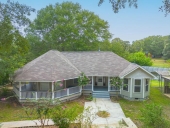Hi everyone,
I’m new to the forum and to RMHs but really excited to dive in… In the spring, we plan on putting up two 21’-diameter yurts to live in and we want to heat them with an RMH.
I’m intimidated by all that’s out there on RMHs and am hoping I can get some suggestions for what RMH design would be appropriate for our situation…. (Once I’ve determined that, I’ll need to educate our building code enforcer about RMHs and the one we want to build so that he has enough information to “perform a comprehensive inspection of the installation in order to sign off on it.” Once he’s given us the ok to proceed with the RMH, I’ll work on learning how to build it…)
Here are some details for our yurt plans:
- We’re purchasing the two yurts from
https://yurta.ca; they’re each 21’ in diameter, translating to about 346 sq feet per yurt, for a total of 692 sq feet.
- The yurts use 100% wool insulation lining (F11 wool), needled to 1/4-1/2” thick
- The yurts will be on a single raised wood deck (that has wood siding around it to keep wind out from underneath).
- I’m not sure what the interior floor will be and how we’ll insulate the flooring – that will be another thread… (I’d love it to be an earthen floor if that’s possible and wise…)
- The yurts will be connected to each other (there will be a doorway going from one to the other).
- The current plan is for one yurt to have the kitchen, living room, and small office/guest room, while the other yurt will have the bathroom and a bedroom (we might try to put a lofted bed on top of the bathroom), though the floor plans are still evolving and we're open to making changes….
- We plan on living in these yurts for the foreseeable future, but it’s possible we’ll get tired of it and need to take them down or move them to make room for some other structure (we live in an intentional community and have only a small lot on which we can build a home, so there probably wouldn’t be room to build an additional structure next to the yurts). So it’s possible that we may need to remove or relocate the RMH in the future…
- We live in Danby, which is near Ithaca, NY – Zone 6
- I have no background with building RMHs or related skills. I'm eager to learn, but am hoping for an RMH design that's beginner-friendly...
My two questions are:
1. Can we get away with a single RMH or should we go with two RMHs? The yurt company (Yurta) says that most of their clients heat them with wood stoves but that you’d need a separate wood stove in each yurt. If using a single RMH, would we need to somehow run piping (maybe through the floor and wood deck?) to a thermal mass in the other yurt?
2. What RMH design should we use? Would a pebble style make sense because it would be easier to disassemble if needed? Or one of Uncle Mud’s Cottage Rockets? Something else? Relatedly, I’m also not sure if we should be going with an RMH designed for a smaller space (given the size of the yurts) or with something designed for a larger space since the insulation in our walls will be relatively low.
Thanks so much for your help!
Matt








